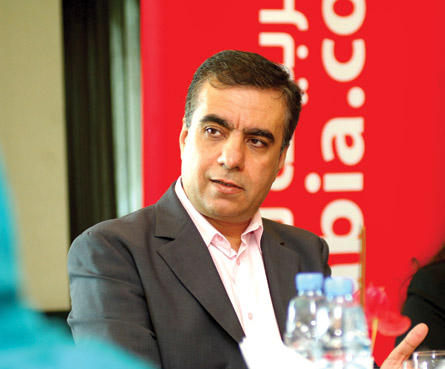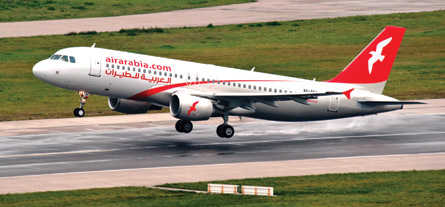Early airliners were refuelling at Sharjah when Dubai airport was nothing more than a dream and patch of desert. Today the airports are a 20min drive apart, but Sharjah's modest facility is a world away from its high-flying neighbour's teeming three-terminal global hub. However, Air Arabia chief executive Adel Ali is delighted with the once-sleepy airport that has been its base since the Gulf's first low-cost airline began services in October 2003.
"When we launched we wanted somewhere that wasn't congested, where we could have a quick turnaround and flexibility on aircraft movement," he says, speaking in the carrier's unprepossessing headquarters, a corridor of offices on the first floor of Sharjah's cargo hangar. "Passengers want to spend as little time as possible at airports. With us, they can be from touchdown to car in 15min."
 |
|---|
© BillyPix Ali: touchdown to car in 15min |
After starting with two leased aircraft, today Air Arabia has a fleet of 30 Airbus A320s. The privately-owned airline placed an order for a further 44 of the type in 2007, nine of which have been delivered. Another five will come this year and by the time they all arrive in 2016 the fleet will be over 50 aircraft, the majority of them owned.
However, despite that rapid expansion, Ali insists the Air Arabia model has never been about growth at the expense of the bottom line and customer service. "We always said there was one thing we would not do, and that was order planes to be the biggest low-cost carrier for the sake of it. We will only do it when it will not endanger profitability. Shareholders have trusted us with their money and we are accountable for it," he says.
A common perception of the Gulf's low-cost airlines is no-frills "buses" providing links to the Indian subcontinent and the parts of the Middle East and Africa that provide the bulk of the region's manual guest workers. But that is only part of Air Arabia's demographic. Students from Sharjah University and passengers from the northern emirates wanting to avoid Dubai's busy airport and expensive parking charges are among its regular customers. "Our market mix is very interesting," says Ali. "We even have a lot of VIPs, travelling with their families."
Key to the Air Arabia no-frills-plus offering are features such as 32" seat pitches - its A320s have 12 seats fewer than the 180 maximum - and an online food pre-ordering service. "I challenge anyone to better our menus," says Ali. "So long as you pay you can get almost anything you want." (Alcohol excepted: it is banned in the dry emirate.) As yet, allocated seating is not offered. Passengers seem to approve of the product. "As long as we see an 80% load factor and yields are fine, there is no need to change," he says.
 |
|---|
© Air Arabia Air Arabia's A320s have 12 seats fewer than the 180 maximum and offer 32in seat pitches and an online food pre-ordering service |
Air Arabia employs 300 pilots. Most are recruited as first officers, but the airline does occasionally take on direct-entry captains as well as second officers, many of them sponsored Emirati cadets trained for a multi-crew pilot licence (MPL) in partnership with Alpha Training in Sharjah. Although its all-A320 fleet means there is a large pool of qualified potential recruits, the carrier has offered conversion courses to non-type-rated pilots when supply has been tight.
Like all airlines in the region, its pilots come from many countries. "When we launched, we had quite a few Canadians as Air Canada was in trouble and furloughing pilots," says Ali, a former executive with Gulf Air and British Airways. "Today, we have something like 40 nationalities represented."
True to its low-cost ethos, its approach to looking after pilots is very different to the paternalistic policy of the region's network airlines. Emirates, for instance, provides housing and transport to and from work for its flightcrew and many families live together on Emirates-owned developments. Air Arabia pilots are left to their own devices.
"Life has changed from the 1960s," says Ali, referring to the frontier-style expat lifestyle of the colonial era. "We pay them a lump sum. If a captain chooses to live in a two-bed apartment rather than a villa and spend his money on something else that is up to him." Ali dismisses the idea that such a laissez-faire attitude can be a disincentive to working for the airline: "People will come to you if you pay them the market rate."
Alone among Middle Eastern airlines, Air Arabia has pioneered a multi-base strategy with four aircraft based in Casablanca, Morocco since 2009, and three in the Egyptian city of Alexandria, a base established in June 2010. Although, in retrospect, the timing of the Egypt move was not ideal - last year's upheavals decimated the tourism market - Ali believes business will pick up. "No one could have predicted the Arab Spring," he says. "But Egypt has a big population and a huge tourist industry. It will come back."
Although the Moroccan and Egyptian operations are run as separate subsidiaries, majority-owned by local investors, the product remains exactly the same. "Customers get a seamless service," says Ali. Although plans to develop further bases will have to wait until "the whole region stablises and settles down", Ali believes that the Air Arabia brand gives the airline an opportunity to "operate anywhere in an area from the Atlantic coast to Oman". Several airports have made approaches, says Ali. "We will keep looking at opportunities."
The carrier has been consolidating its position in Sharjah, where it is the only domestic airline. Last year it began doing its own line maintenance and has just opened a training centre with an A320 full-flight simulator. It has even invested in building the airport's first hotel. Although the pattern among low-cost carriers in Europe and elsewhere has been to outsource almost everything, Ali says placing these operations in-house makes sound economic sense.
"We needed the infrastructure to support the business. Outsourcing is good, but as you grow it becomes more expensive," he says. "The simulator saves us a lot of money and time because pilots don't have to travel to other airports or countries and work to these companies' schedules."
Source: Flight International























